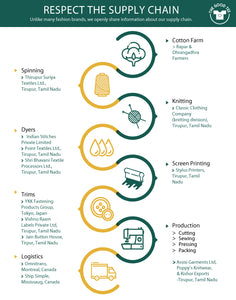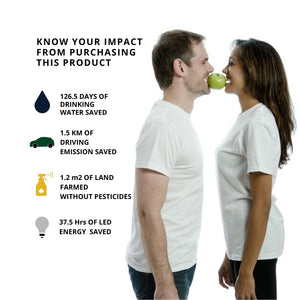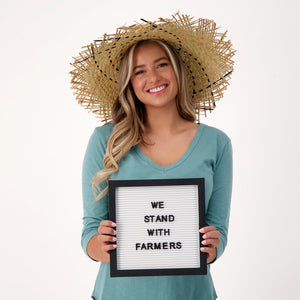#TheGoodTribe Interview with Bayan Alkhatib, Founder of Bays Threads

Landfills all over the globe are a major source of pollution; the trash takes years to break down and remains a major problem for future generations. A contributing factor to these overflowing landfills is textile waste. An endless amount of unwanted and unused clothes are thrown away. In fact, North Americans send over 10 million tonnes of clothing to landfills every year, 95% of which can be reused or recycled.
Bayan Alkhatib took the saying “one man’s trash, is another man’s treasure” and founded a business of upcycled clothes that are almost always sold out instantly! Bayan Alkhatib, the founder of Bays Threads sources her materials from thrift and vintage stores and redesigns them into a new piece of clothing for someone to love again.
This week we had the opportunity to interview Bayan and found out how she managed to create such a successful business and why upcycling clothes can be beneficial to the planet.
1. Tell us about your journey and how Bays Threads began!
It all began in quarantine when I turned 21. The boredom got real for me so I decided to adventure out and purchase a sewing machine. My aunt was living with us at the time and she just so happens to be a seamstress in Jordan and creates all types of different clothing. I owe it all to her as someone who taught me the very basics of sewing. How to thread a needle, how to play around with the bobbin thread, and basically how to just operate a sewing machine. In high school, I resold a lot of my old clothes or would thrift a lot of clothes and resell them on Apps you can find second-hand clothing like Poshmark or Depop. I made a good extra buck doing that, after all, I hated my part-time job. Once I got into sewing, I started playing around with a lot of different fabrics. Curtains, blankets, even bedding covers. Once I got a good handle on how to stitch properly, I started taking all of my dad‘s old T-shirts and turning them into a shirt and shorts set or simply cutting & hemming them to be a crop top.

I started doing research and finding a lot of inspiration through Instagram and Pinterest when I came across a few photos of women talking about upcycling clothing. It was then I instantly fell in love with the idea of recycling clothing or taking old clothing and reworking it into something unique. And it was only a plus that it’s sustainable and good for the environment. In my household, we try to be as sustainable as possible. We have our own compost, we recycle everything, and we use little to no plastic wear. I was brought up to not be so wasteful. From what I remember, my parents were one of the most frugal people, so the idea of recycling clothing was not the biggest surprise to me, especially if it meant I can get inspired and create one-of-a-kind pieces.

2. What makes vintage fashion so unique to rework and upcycle?
It’s such a cool thing to do. You get to take something old and boring and completely revamp it based on the inspiration you gained with your own ideas. There’s really nothing like it. Especially if it’s vintage. Vintage clothing is anywhere between 10 to 25+ years old. So to be able to give old pieces of clothing a new look is so rewarding. Vintage clothing is especially so humbling to rework because a shirt that old can tell so many stories. It’s admirable seeing a piece so old to be ripped up or have marks or stains or paint drops all over, it really gives you a perspective on where this piece might’ve come from or who could’ve possibly owned it years and years ago and where they could’ve worn it to and what that piece of clothing made them feel like when wearing it. Something so old that’s been through so much

3. How and where do you source your materials? What is the process involved?
A lot of times I simply source my materials at my local thrift stores or I travel to vintage stores or other thrift shops all over to find the perfect piece to repurpose. More unique pieces that may be harder to find, I source online through other people reselling their secondhand clothing. The process involved can sometimes be tedious when actually getting down and dirty. I’ve broken plenty of needles and jammed my sewing machine more times than I can count. All of my sweaters can take me a couple of hours to repurpose. The sweatpants that I repurpose take me anywhere between 5 to 6 hours. The longest it took me to create a piece was 9 whole hours but it was well worth it once I was able to see the final piece.

4. How do reworking and upcycling clothes help attain a sustainable future in the fashion industry?
We’re all guilty of buying clothing from fast fashion brands. Hell, I am too. We’re not perfect. But to purchase from a thrift store or any designer curating with some sort of second-hand material, means YOU ARE helping the environment more than you know. Fast fashion has an impact on the environment through carbon emissions. The fast fashion industry is responsible for 10% of global CO2 emissions each year. Its use of cheap and toxic textile dyes is what’s killing our planet and essentially hurting you. And don’t even get me started on how much water is used to make just one piece of clothing. When throwing away textiles, it all ends up in landfills, which don’t decompose for 200+ YEARS. Repurposing takes usable items and turns them into items that people can use, keeping pressure off the landfills and disposal areas. By reducing the amount of trash in our current waste areas we are protecting future lands from becoming landfills themselves. So next time, instead of tossing out your shirt that has rips and tears and stains all over your closet, use your imagination and recreate it with another piece of sustainable material and make it look totally and completely unique.

5. I noticed that your products are mostly sold out! Any advice for other business owners on how they achieve the same?
Find your target market. Follow the trends. Do your research and know-how to market yourself and your business. And most importantly, create products that you love of course, but focus mostly on what’s going to sell. Sometimes clothing store owners fall victim to getting caught up on having inventory that they think looks good or what they can get their hands on that’ll cost the least for them but they don't prioritize whether it’ll sell well or not. Study your audience and decipher what THEY want to see.
6. What was your favorite clothing piece to rework and upcycle?
This reversible jacket was easily my favorite piece that I upcycled. At first, I had sourced this textured sweater to do as a rework with another solid color hoodie. But once I was able to then source a black denim jacket that coincidentally was the same size as the textured sweater, I knew it was fate. The vibrant colors and the meticulous quality behind repurposing this old denim jacket made me in awe of the final piece. It was so hard to sell this one, probably one of the hardest ones I had to let go of. But it was well worth it.

7. Any big plans for the business in 2022 and beyond?
I’m always planning what I want to design next for each season. But in terms of goals for my business itself in 2022 and beyond? I have none. For the last two years, I have kept doing what I’m doing which includes letting fate simply ride out and do its thing with Bays Threads. Luckily, every single thing has been nothing short of amazing since. I don’t want to get my hopes up and lead to disappointment in something that I’ve planned to do if it doesn’t work out. Or I don’t want to do something so grand and let it feed into my ego enough to where I’m gonna crave for more. Because let’s be real, greed leads to failure, and badass girl bosses aren’t greedy and they’re sure as hell, not failures. I just wanna continue being a good example for anyone who doesn’t know where to start and take care of our planet in any way that I can because we only get one!
We love that Bays Threads doing its part to reduce textile waste! Other than using biodegradable materials, another creative and fun way would be by upcycling clothes. Bays Threads provide you with the option to purchase one-of-a-kind pieces. Maybe those thrifted clothes aren’t that unwanted after all!







Leave a comment